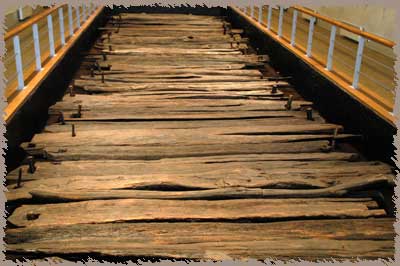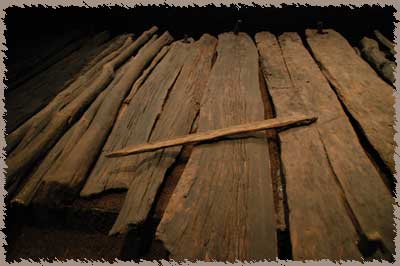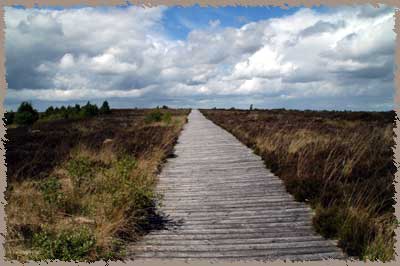
Details
Cº Longford
Heritage Site
OS Grid N 103 625
open daily 1000-1700
tours avail.
Miscellaneous Photos
Photos
neolithic sites
abbeys and churches
castles
dublin
waterford
round towers
lovely scenics
Links
travelogue, 5.21Irish Heritage Site
Archaeology
Ancient Ireland
Wikipedia
Discover Ireland
Types of Peat Bogs
Bord na Mona

the reconstructed Neolithic trackway at the Corlea bog
 Bogs are part of Irish life -- raised bogs and blanket bogs are found nearly everywhere, and peat moss and turf harvested from them has been a common fuel source for centuries. A raised bog is formed when a small lake or depression fills in with plant matter to become a fen, and the subsequent years continue to lay down plants and decaying matter until the bog rises above the fen. In some cases, they have been laying down layers for roughly 10,000 years, and in some cases are more than 12 meters above the surrounding area. A raised bog is mostly water (about 95%) and acts as a huge sponge. As peat and turf are harvested with huge machines, they often uncover structures and even people buried in the ground. This is how they found the Corlea Trackway, a "bog road" that dates to roughly 148 BCE and is currently being preserved in place in teh bog.
Bogs are part of Irish life -- raised bogs and blanket bogs are found nearly everywhere, and peat moss and turf harvested from them has been a common fuel source for centuries. A raised bog is formed when a small lake or depression fills in with plant matter to become a fen, and the subsequent years continue to lay down plants and decaying matter until the bog rises above the fen. In some cases, they have been laying down layers for roughly 10,000 years, and in some cases are more than 12 meters above the surrounding area. A raised bog is mostly water (about 95%) and acts as a huge sponge. As peat and turf are harvested with huge machines, they often uncover structures and even people buried in the ground. This is how they found the Corlea Trackway, a "bog road" that dates to roughly 148 BCE and is currently being preserved in place in teh bog.

pins were used to secure the road to the bog surface
The trackway is built of enormous oak timbers, pegged together and pinned ot the earth with long stakes. It is a fairly advanced form of road -- other versions include a simple pathway of boards laid end-to-end, or bundles of rods lengthwise on the bog surface. Each of these would be for pedestrian traffice. Hurdle tracks, which used panels of bundled rods, and sturdier versions laid planks over this "subfloor" to hold extra weight. The trackway uncovered in Corlea is of this final sort, and represents the highest form of roadbuilding. The planks are split oak, up to 4m wide and laid edge to edge over a foundation of parallel tracks. The ends of some of the planks have holed where long pins were placed to keep them in place. Hundreds of trees were felled and split to make the rodway, which was obviously intended for wheeled traffic.

the modern extension of the trackway, along the same path
The trackway here has been restored and stabilzed, and represents about 80 meters of a kilometer or more road. It is a marvel of woodworking, but of engineering? Not so much. There is clear evidence that it sank into the bog aafter only a few years.